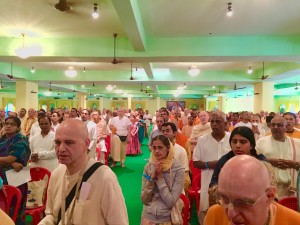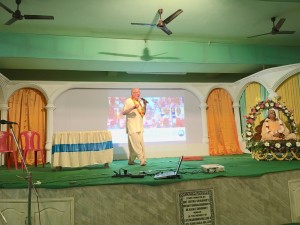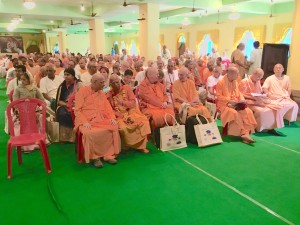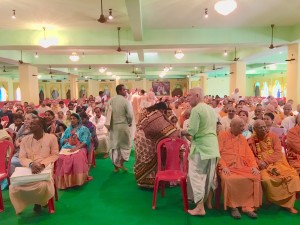
By Romapada Das
The grand annual Mayapur festival began today with the inaugural session of the ISKCON Leadership Sangha (ILS 2016) with 1,200 delegates attending 87 seminars spread over 12 venues at ISKCON Mayapur. ILS 2016 features a spectacular 50th Anniversary Expo highlighting the achievements of ISKCON, and stalls from various international projects such as Vanipedia, ISKCON Congregation services, TOVP, Varnashrama Museum of the Sacred Art, Govardhan Eco Village and several others.
Speaking at the plenary session on the inaugural day, GBC Chairman, Praghosh Das said, “This year, ILS has been hosted in partnership with our 50th Anniversary Committee and the TOVP. The 50th anniversary is a very important milestone in the history of ISKCON. At the inaugural event in Kolkata, more than 20,000 people had attended a spectacular show of a kind never witnessed before in our history. Srila Prabhupada’s ISKCON is the most important movement in the world. People are suffering in this material world, and ISKCON can remove the root cause of suffering to take all of us back to Goddhead.”
Over 60 presenters will present 87 seminars over the next eight days covering subjects such as devotee care, community outreach, online preaching, marketing, communications, introspection, strategic planning, the position of Srila Prabhupada, sustainable Vaishnava communities, temple development and administration, team building, arts and education.
Gopal Bhatta Das, who oversees the ILS on behalf of the GBC Strategic Planning Committee said, “The mood of the leaders who are assembled here today is ‘simply wonderful’. The vision of the ILS is to allow leaders to share their service with their peers and with the members of the GBC – an opportunity for association, vision, inspiration, and education in the holy dhama of Mayapur.”
“Coming to the ILS was one of the best decisions I made this year,” revealed Visnu Nam Das, Vice President of ISKCON Ahmedabad, a first-time delegate at the ILS. “The amount of learning and association I’ll get over the next eight days is mind-boggling. I feel overwhelmed by the mood of everyone in the holy dham and grateful for the opportunity to be here.”
Delegates heard a presentation by Vaisesika Das on his new book, ‘Our family business’ launched by the BBT. The book discusses the importance of book distribution as the corner-stone for preaching the Krishna consciousness movement.
Later, Pancharatna Das and Gopal Bhatta Das led an interactive session to discuss the vision of ISKCON. Participants broke into smaller groups to discuss where they wanted to see ISKCON in the future, and wrote an individual statement of vision, which they pasted on a wall.
“These statements will be collected and analysed, as a precursor to an ongoing project for drafting the vision statement of ISKCON,’ said Pancharatna Das. “Every organization needs a strong vision statement that will reveal future aspirations at the core of our existence. Even Lord Chaitanya revealed his mission statement when he said that His name would be preached in every town and village on this planet. The ILS has offered an opportune moment for us to seek the views of our leaders that will help in drafting our mission statement during the 50th anniversary.”
Every evening, ILS delegates will have an opportunity to collect for enlivening kirtan sessions in a specially erected tent, which will also see the launch of the ISKCON 50 movie.
“The real purpose at the ILS is to facilitate devotees in experiencing and imbibing the creative and profound wisdom that devotional practitioners bring from their different fields. Each of the seminars will leave our delegates energised with introspective realisations that our presenters bring to the Sanga,” concluded Gopal Bhatta Das.










 Handymen are very handy! And Rick Baker is one such man. When we sent a message to the parents, asking for their assistance with keeping the deities’ washing cloths clean, Rick immediately volunteered. But Tarannum Mataji was faster and got that service already. We then suggested that Rick take care of the children’s cloths. Rick decided to take it to the next level. He went and purchased a couple of hygiene (touch-free) paper towel dispensers and installed them in the bathrooms too!
Handymen are very handy! And Rick Baker is one such man. When we sent a message to the parents, asking for their assistance with keeping the deities’ washing cloths clean, Rick immediately volunteered. But Tarannum Mataji was faster and got that service already. We then suggested that Rick take care of the children’s cloths. Rick decided to take it to the next level. He went and purchased a couple of hygiene (touch-free) paper towel dispensers and installed them in the bathrooms too!
 By Mark D. Vickers
By Mark D. Vickers




 By Srila Jiva Gosvami
By Srila Jiva Gosvami









 Where can you find nouns? Everywhere! Lower Elementary students played “Noun Hunt” around the classroom, gathering various items. They named and described the nouns, then added verbs and created complete sentences.
Where can you find nouns? Everywhere! Lower Elementary students played “Noun Hunt” around the classroom, gathering various items. They named and described the nouns, then added verbs and created complete sentences. 




 By His Divine Grace A. C. Bhaktivedanta Swami Prabhupada
By His Divine Grace A. C. Bhaktivedanta Swami Prabhupada
